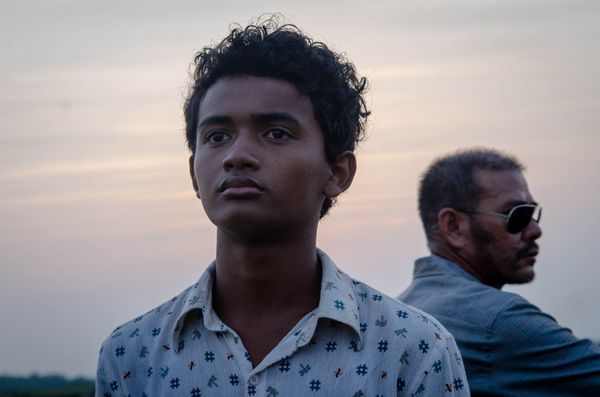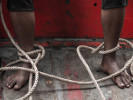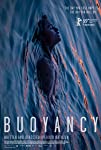Eye For Film >> Movies >> Buoyancy (2019) Film Review
Buoyancy
Reviewed by: Amber Wilkinson

The arc of Rodd Rathjen's tale of modern day slavery may be familiar but it's firmly embedded in the harsh realities of life for all-too many young Cambodians who find themselves trapped at sea as forced labourers. Even before that, teenage Cambodian Chakra (Sarm Heng) doesn't have it easy and writer/director Rodd Rathjen shows his keen eye for visual storytelling from the start as we watch the 14-year-old hefting a bag of rice on his shoulders along a road in the heat as other kids of a similar age stream past him in their school uniforms.
The only school Chakra is destined for is the one involving hard knocks, as his dad is literally and figuratively farming him out to help with local crop sowing and fertilising. No wonder then that the tales of the 8000 baht a month he could earn in Thailand sound appealing. Even the money to travel there is no barrier, he's told, he can borrow it from the broker and pay them back once he's earning. We know what this means before Chakra does, of course, as he finds himself hived off with another older man, Kea (Mony Ros) and told that as they don't have the fee they must work in "a different factory" from those that do.

The factory, it turns out, is a fishing boat, where the pair are soon set to work hefting and shovelling for Thai captain Rom Ran (Thanawut Ketsaro), who runs his ship with the sort of off-hand but cheerfully brutal violence that really makes your skin crawl. The end of the day brings only a cup of rice and a handful of hours sleep before the process must be repeated. Rathjen captures the monotony of this existence and the casual violence of it with mounting tension as Chakra himself becomes brutalised - we view key violent acts, not by watching them, but by observing the effect they have on the youngster. There's an emphasis on the crushing physicality of the work, stitched through with a quiet desperation that it may never end, with Chakra and Kea's hopes of reprieve fading like the number 11 on the back of Chakra's T-shirt (sharp costume work from Salin Kuong).
As the days wear on, Rom Ran starts to treat Chakra like a sort of neglected pet, tossing him scraps of fish now and again, while the older men prove less resilient in the face of slave rations. Given the physicality of the work, there's little place for small talk but newcomer Heng conveys the mixture of loss, anger and resilience of Chakra with impressive skill, while Ketsaro avoids caricature to bring a blend of swagger and underlying intelligence to Rom Ran, while also allowing his character to show the merest flicker of how unsettled Chakra's ability to stare him down makes him. By focusing on the physical rather than mental state of his protagonist, Rathgen, whose film has been selected as Australia's Foreign Language Oscar nominee, forces us to consider the lack of time and energy, not just to think about escape, but to think about anything other than survival. There are thought to be about 200,000 boys and men on slave ships like these - and the greatest of all the horrors, perhaps, is that all this suffering is for fish used in dog food. Something for us all to chew on.
Reviewed on: 27 Dec 2020















